d.ecs storage manager FileLock
The FileLock module allows d.ecs storage manager to store documents on a partition protected with GrauData FileLock.
Note
FileLock must be installed in the version 2.3.
Warning
To store the documents with d.ecs storage manager on a FileLock volume, it is essential that the default, minimum, and maximum retention period for the FileLock volume are set equivalent to the retention periods in the leading system (d.3/ecspand).
Configuration
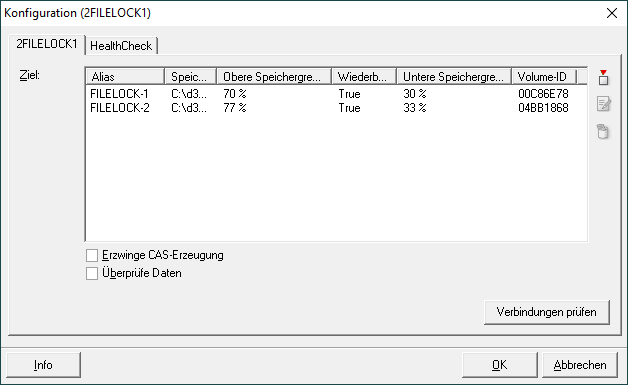 |
Objective: List of the target paths where the documents are stored and their properties.
Alias: Alias name of the volume.
Storage path: Target path where the documents are stored.
Upper storage limit: Specifies how much storage space may be used for storing data.
Rewritable: If this option is set, the data will be re-written as soon as the available storage space falls below the Lower storage limit.
Lower storage limit: Specify the percentage of disk space which may be occupied before documents can be stored again.
Volume ID: Every storage path gets a unique volume ID.
CAS-creation: If this option is enabled, then the documents are stored in CAS containers. These containers have a unique ID which is used to verify the consistency of a document during restore. (During the retrieval it is checked, if the data in a CAS container are unchanged before a document is passed on to the d.3 server / d.3 gateway / API). Should be enabled in connection with ecspand.
Validate data: If this option is enabled, then a file comparison based on the "RipeMD256" mechanism is performed after having copied a file to the FileLock volume. This ensures that the file as completely transferred.
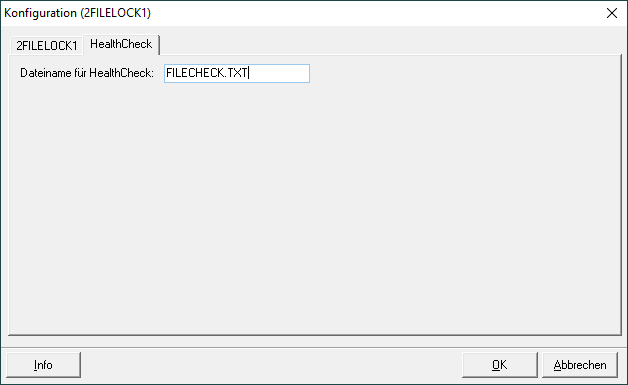 |
File name for HealthCheck: File name to be used during the system check by the HealthCheck process.
Volume configuration
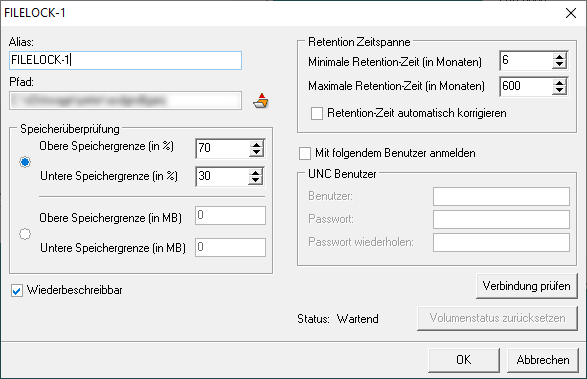 |
Alias: Alias name for the volume. If a name is specified here then this is used instead of the volume ID in the web interface. This is used for a better overview.
Storage path: Specify a path here where the documents are stored
Upper storage limit (in %): Here you can define a percentage of how much storage space may be used for the storage of data.
Lower storage limit (in %): Specify the percentage of hard disk space which may be occupied before documents can be stored again.
Upper storage limit (in MB): Specify the percentage of hard disk space which may be occupied before documents can be stored again.
Lower storage limit (in MB): Specify the percentage of hard disk space which may be occupied before documents can be stored again.
Rewritable: This option is only available, if more than one volume is configured and specifies, if a volume should be rewritten as soon as the lower storage threshold of the volume is exceeded (e.g. by deleting old documents).
Minimum/maximum retention period (in months) This option is only available, if more than one volume is configured and specifies, if a volume should be rewritten as soon as the lower storage threshold of the volume is exceeded (e.g. by deleting old documents).
Automatically correct retention period: If a retention-period outside the specified range is passed by a delivering process, then the time is automatically set to the minimum or maximum, if this parameter is enabled. Else the job is blocked and the document is not written to the secondary storage.
Log in with the following user: If this parameter is enabled, the d.ecs storage manager automatically tries to log in to the respective volume. This parameter only has to be enabled, if the d.ecs storage manager is executed under a user account which does not have access to the volume.
User: User to be used for the login to the volume.
Password/Confirm password: Password of the user to be used for the login to the volume.
Status: One of three possible values of the volume is displayed. Use the Reset volume status button to reset the status of a volume to Waiting.
Waiting: There is currently no writing on the volume.
Writing: Currently writing on the volume.
Full: The volume was written on until it exceeded the configured memory limits. The volume cannot and will no longer be written to.
Configuration of the FileLock volume
The configuration of the FileLock volume has various requirements which will be described below.
Set the partition to WORM mode with the setting 1st Directory Level.
Set the folder to be enabled for FileLock to the SnapLock Functionality Mode.
It is recommended that the values Minimum Retention and Default Retention are set to 0 and Maximum Retention to the highest retention period defined in d.3/ecspand. This avoids possible issues when setting the retention period through the d.ecs storage manager. Else, the FileLock overwrites the retention periods set by the d.ecs storage manager automatically with the specified defaults.
The parameter Auto Commit must not be enabled, as the FileLock then automatically locks documents and under certain conditions this interferes with the procedures of the d.ecs storage manager.
A configuration could thus look as follows. In this example the maximum retention period is set to 70 years.
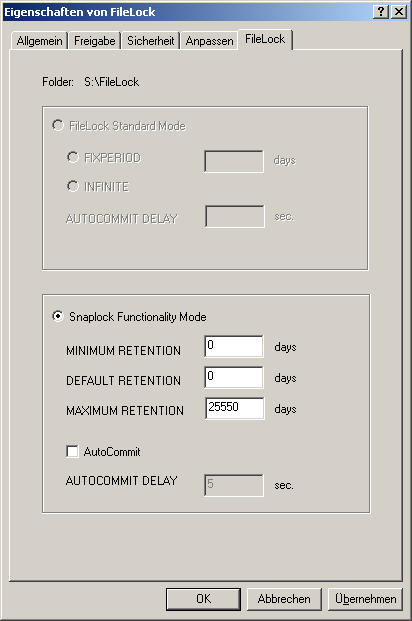 |
Index recovery
The d.ecs storage manager FileLock module allows to recover the internal document index after a loss. For this effect, it browses the specified target directory for documents and thus rebuilds the index. This type of index recovery should only be used, if no index-recovery-files (*.IR) exist to restore the index (also see Tab: Database logging).
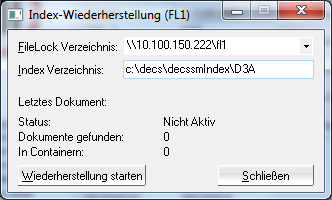 |
FileLock directory: Directory in the FileLock system to be searched for documents.
Index directory: Directory where the index should store the documents for the FileLock system.